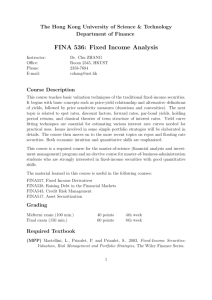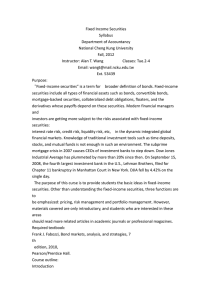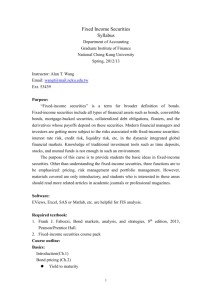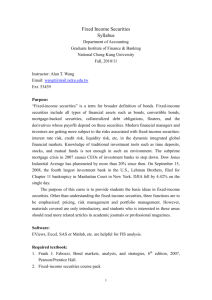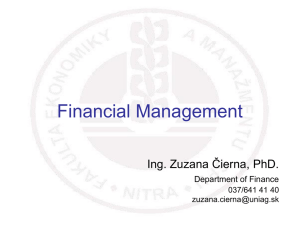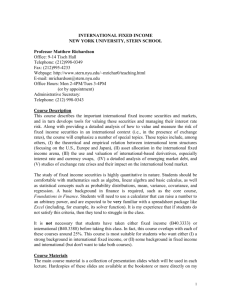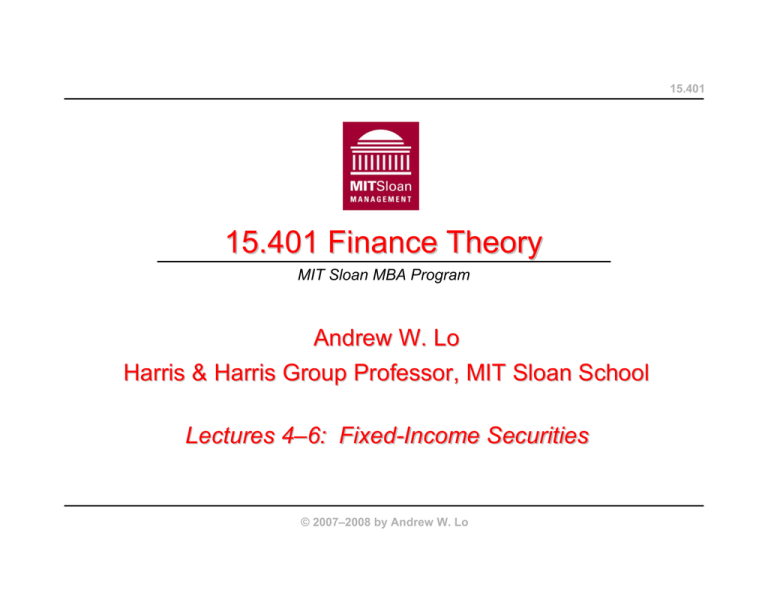
15.401
15.401 Finance Theory
MIT Sloan MBA Program
Andrew W. Lo
Harris & Harris Group Professor, MIT Sloan School
Lectures 4–6: Fixed-Income Securities
© 2007–2008 by Andrew W. Lo
Critical Concepts
15.401
Industry Overview
Valuation
Valuation of Discount Bonds
Valuation of Coupon Bonds
Measures of Interest-Rate Risk
Corporate Bonds and Default Risk
The Sub-Prime Crisis
Readings
Brealey, Myers, and Allen Chapters 23–25
Lectures 4–6: Fixed-Income Securities
© 2007–2008 by Andrew W. Lo
Slide 2
Industry Overview
15.401
Fixed-income securities are financial claims with promised cashflows of
known fixed amount paid at fixed dates.
Classification of Fixed-Income Securities:
Treasury Securities
– U.S. Treasury securities (bills, notes, bonds)
– Bunds, JGBs, U.K. Gilts
– ….
Federal Agency Securities
– Securities issued by federal agencies (FHLB, FNMA $\ldots$)
Corporate Securities
– Commercial paper
– Medium-term notes (MTNs)
– Corporate bonds
– ….
Municipal Securities
Mortgage-Backed Securities
Derivatives (CDO’s, CDS’s, etc.)
Lectures 4–6: Fixed-Income Securities
© 2007–2008 by Andrew W. Lo
Slide 3
Industry Overview
15.401
U.S. Bond Market Debt 2006 ($Billions)
Asset-Backed,
2,016.70, 8%
Money
Markets,
3,818.90, 14%
Municipal,
2,337.50, 9%
Treasury,
4,283.80, 16%
Federal
Agency,
2,665.20, 10%
Corporate,
5,209.70, 19%
Lectures 4–6: Fixed-Income Securities
MortgageRelated,
6,400.40, 24%
© 2007–2008 by Andrew W. Lo
Slide 4
Industry Overview
15.401
Courtesy of SIFMA. Used with permission. The Securities Industry and Financial Markets Association (SIFMA) prepared
this material for informational purposes only. SIFMA obtained this information from multiple sources believed to be reliable
as of the date of publication; SIFMA, however, makes no representations as to the accuracy or completeness of such third
party information. SIFMA has no obligation to update, modify or amend this information or to otherwise notify a reader
thereof in the event that any such information becomes outdated, inaccurate, or incomplete.
Lectures 4–6: Fixed-Income Securities
© 2007–2008 by Andrew W. Lo
Slide 5
Industry Overview
15.401
U.S. Bond Market Issuance 2006 ($Billions)
Asset-Backed,
674.6, 16%
Federal
Agency, 546.9,
13%
Corporate,
748.7, 17%
Lectures 4–6: Fixed-Income Securities
Municipal,
265.3, 6%
Treasury,
599.8, 14%
MortgageRelated,
1,475.30, 34%
© 2007–2008 by Andrew W. Lo
Slide 6
Industry Overview
15.401
Courtesy of SIFMA.Used with permission. The Securities Industry and Financial Markets Association (SIFMA) prepared
this material for informational purposes only. SIFMA obtained this information from multiple sources believed to be reliable
as of the date of publication; SIFMA, however, makes no representations as to the accuracy or completeness of such third
party information. SIFMA has no obligation to update, modify or amend this information or to otherwise notify a reader
thereof in the event that any such information becomes outdated, inaccurate, or incomplete
Lectures 4–6: Fixed-Income Securities
© 2007–2008 by Andrew W. Lo
Slide 7
Industry Overview
15.401
Courtesy of SIFMA. Used with permission. The Securities Industry and Financial Markets Association (SIFMA) prepared
this material for informational purposes only. SIFMA obtained this information from multiple sources believed to be reliable
as of the date of publication; SIFMA, however, makes no representations as to the accuracy or completeness of such third
party information. SIFMA has no obligation to update, modify or amend this information or to otherwise notify a reader
thereof in the event that any such information becomes outdated, inaccurate, or incomplete.
Lectures 4–6: Fixed-Income Securities
© 2007–2008 by Andrew W. Lo
Slide 8
Industry Overview
15.401
Fixed-Income Market Participants
Issuers:
Governments
Corporations
Commercial Banks
States
Municipalities
SPVs
Foreign Institutions
Lectures 4–6: Fixed-Income Securities
Investors:
Intermediaries:
Primary Dealers
Other Dealers
Investment Banks
Credit-rating Agencies
Credit Enhancers
Liquidity Enhancers
© 2007–2008 by Andrew W. Lo
Governments
Pension Funds
Insurance Companies
Commercial Banks
Mutual Funds
Hedge Funds
Foreign Institutions
Individuals
Slide 9
Valuation
Cashflow:
Maturity
Coupon
Principal
15.401
Example. A 3-year bond with principal of $1,000
and annual coupon payment of 5% has the
following cashflow:
Lectures 4–6: Fixed-Income Securities
© 2007–2008 by Andrew W. Lo
Slide 10
Valuation
15.401
Components of Valuation
Time value of principal and coupons
Risks
– Inflation
– Credit
– Timing (callability)
– Liquidity
– Currency
For Now, Consider Riskless Debt Only
U.S. government debt (is it truly riskless?)
Consider risky debt later
Lectures 4–6: Fixed-Income Securities
© 2007–2008 by Andrew W. Lo
Slide 11
Valuation of Discount Bonds
15.401
Pure Discount Bond
No coupons, single payment of principal at maturity
Bond trades at a “discount” to face value
Also known as zero-coupon bonds or STRIPS*
Valuation is straightforward application of NPV
Note: (P0, r, F) is “over-determined”; given two, the third is determined
Now What If r Varies Over Time?
Different interest rates from one year to the next
Denote by rt the spot rate of interest in year t
*Separate Trading of Registered Interest and Principal Securities
Lectures 4–6: Fixed-Income Securities
© 2007–2008 by Andrew W. Lo
Slide 12
Valuation of Discount Bonds
15.401
If r Varies Over Time
Denote by Rt the one-year spot rate of interest in year t
But we don’t observe the entire sequence of future spot rates today!
Today’s T-year spot rate is an “average” of one-year future spot rates
(P0,F,r0,T) is over-determined
Lectures 4–6: Fixed-Income Securities
© 2007–2008 by Andrew W. Lo
Slide 13
Valuation of Discount Bonds
15.401
Example:
On 20010801, STRIPS are traded at the following prices:
For the 5-year STRIPS, we have
Lectures 4–6: Fixed-Income Securities
© 2007–2008 by Andrew W. Lo
Slide 14
Valuation of Discount Bonds
15.401
Suppose We Observe Several Discount Bond Prices Today
Term Structure of Interest Rates
Lectures 4–6: Fixed-Income Securities
© 2007–2008 by Andrew W. Lo
Slide 15
Valuation of Discount Bonds
15.401
Term Structure Contain Information About Future Interest Rates
r0,t
Maturity
What are the implications of each of the two term structures?
Lectures 4–6: Fixed-Income Securities
© 2007–2008 by Andrew W. Lo
Slide 16
Valuation of Discount Bonds
15.401
Term Structure Contain Information About Future Interest Rates
Implicit in current bond prices are forecasts of future spot rates!
These current forecasts are called one-year forward rates
To distinguish them from spot rates, we use new notation:
Lectures 4–6: Fixed-Income Securities
© 2007–2008 by Andrew W. Lo
Slide 17
Valuation of Discount Bonds
15.401
Term Structure Contain Information About Future Interest Rates
Lectures 4–6: Fixed-Income Securities
© 2007–2008 by Andrew W. Lo
Slide 18
Valuation of Discount Bonds
15.401
More Generally:
Forward interest rates are today’s rates for transactions between two
future dates, for instance, t1 and t2.
For a forward transaction to borrow money in the future:
– Terms of transaction is agreed on today, t = 0
– Loan is received on a future date t1
– Repayment of the loan occurs on date t2
Note: future spot rates can be (and usually are) different from current
corresponding forward rates
Lectures 4–6: Fixed-Income Securities
© 2007–2008 by Andrew W. Lo
Slide 19
Valuation of Discount Bonds
15.401
Example:
As the CFO of a U.S. multinational, you expect to repatriate $10MM from
a foreign subsidiary in one year, which will be used to pay dividends
one year afterwards. Not knowing the interest rates in one year, you
would like to lock into a lending rate one year from now for a period of
one year. What should you do? The current interest rates are:
Strategy:
Borrow $9.524MM now for one year at 5%
Invest the proceeds $9.524MM for two years at 7%
Lectures 4–6: Fixed-Income Securities
© 2007–2008 by Andrew W. Lo
Slide 20
Valuation of Discount Bonds
15.401
Example (cont):
Outcome (in millions of dollars):
The locked-in 1-year lending rate one year from now is 9.04%, which
is the one-year forward rate for Year 2
Lectures 4–6: Fixed-Income Securities
© 2007–2008 by Andrew W. Lo
Slide 21
Valuation of Discount Bonds
15.401
Example:
Suppose that discount bond prices are as follows:
A customer would like to have a forward contract to borrow $20MM three
years from now for one year. Can you (a bank) quote a rate for this
forward loan?
All you need is the forward rate f4 which should be your quote for the
forward loan
Lectures 4–6: Fixed-Income Securities
© 2007–2008 by Andrew W. Lo
Slide 22
Valuation of Discount Bonds
15.401
Example (cont):
Strategy:
Buy 20,000,000 of 3 year discount bonds, costing
Finance this by (short)selling 4 year discount bonds of amount
This creates a liability in year 4 in the amount $21,701,403
Aside: A shortsales is a particular financial transaction in which an
individual can sell a security that s/he does not own by borrowing the
security from another party, selling it and receiving the proceeds, and
then buying back the security and returning it to the orginal owner at a
later date, possibly with a capital gain or loss.
Lectures 4–6: Fixed-Income Securities
© 2007–2008 by Andrew W. Lo
Slide 23
Valuation of Discount Bonds
15.401
Example (cont):
Cashflows from this strategy (in million dollars):
The yield for this strategy or “synthetic bond return” is given by:
Lectures 4–6: Fixed-Income Securities
© 2007–2008 by Andrew W. Lo
Slide 24
Valuation of Coupon Bonds
15.401
Coupon Bonds
Intermediate payments in addition to final principal payment
Coupon bonds can trade at discounts or premiums to face value
Valuation is straightforward application of NPV (how?)
Example:
3-year bond of $1,000 par value with 5% coupon
Lectures 4–6: Fixed-Income Securities
© 2007–2008 by Andrew W. Lo
Slide 25
Valuation of Coupon Bonds
15.401
Valuation of Coupon Bonds
Since future spot rates are unobservable, summarize them with y
y is called the yield-to-maturity of a bond
It is a complex average of all future spot rates
There is usually no closed-form solution for y; numerical methods
must be used to compute it (Tth-degree polynomial)
(P0, y, C) is over-determined; any two determines the third
For pure discount bonds, the YTM’s are the current spot rates
Graph of coupon-bond y against maturities is called the yield curve
Lectures 4–6: Fixed-Income Securities
© 2007–2008 by Andrew W. Lo
Slide 26
Valuation of Coupon Bonds
15.401
U.S. Treasury Yield Curves
Source: Bloomberg
Lectures 4–6: Fixed-Income Securities
© 2007–2008 by Andrew W. Lo
Slide 27
Valuation of Coupon Bonds
15.401
Time Series of U.S. Treasury Security Yields
Lectures 4–6: Fixed-Income Securities
© 2007–2008 by Andrew W. Lo
Slide 28
Valuation of Coupon Bonds
Lectures 4–6: Fixed-Income Securities
© 2007–2008 by Andrew W. Lo
15.401
Slide 29
Valuation of Coupon Bonds
15.401
Models of the Term Structure
Expectations Hypothesis
Liquidity Preference
Preferred Habitat
Market Segmentation
Continuous-Time Models
– Vasicek, Cox-Ingersoll-Ross, Heath-Jarrow-Morton
Expectations Hypothesis
Expected Future Spot = Current Forward
E0[Rk ]
Lectures 4–6: Fixed-Income Securities
=
fk
© 2007–2008 by Andrew W. Lo
Slide 30
Valuation of Coupon Bonds
15.401
Liquidity Preference Model
Investors prefer liquidity
Long-term borrowing requires a premium
Expected future spot < current forward
E[Rk ]
<
fk
E[Rk ]
=
fk − Liquidity Premium
Lectures 4–6: Fixed-Income Securities
© 2007–2008 by Andrew W. Lo
Slide 31
Valuation of Coupon Bonds
15.401
Another Valuation Method for Coupon Bonds
Theorem: All coupon bonds are portfolios of pure discount bonds
Valuation of discount bonds implies valuation of coupon bonds
Proof?
Example:
3-Year 5% bond
Sum of the following
discount bonds:
– 50 1-Year STRIPS
– 50 2-Year STRIPS
– 1050 3-Year STRIPS
Lectures 4–6: Fixed-Income Securities
© 2007–2008 by Andrew W. Lo
Slide 32
Valuation of Coupon Bonds
15.401
Example (cont):
Price of 3-Year coupon bond must equal the cost of this portfolio
What if it does not?
In General:
P = C P0,1 + C P0,2 + · · · + (C + F )PO,T
If this relation is violated, arbitrage opportunities exist
For example, suppose that
P > C P0,1 + C P0,2 + · · · + (C + F )PO,T
Short the coupon bond, buy C discount bonds of all maturities up to T
and F discount bonds of maturity T
No risk, positive profits ⇒ arbitrage
Lectures 4–6: Fixed-Income Securities
© 2007–2008 by Andrew W. Lo
Slide 33
Valuation of Coupon Bonds
15.401
What About Multiple Coupon Bonds?
Suppose n is much bigger than T (more bonds than maturity dates)
This system is over-determined: T unknowns, n linear equations
What happens if a solution does not exist?
This is the basis for fixed-income arbitrage strategies
Lectures 4–6: Fixed-Income Securities
© 2007–2008 by Andrew W. Lo
Slide 34
Measures of Interest-Rate Risk
15.401
Bonds Subject To Interest-Rate Risk
As interest rates change, bond prices also change
Sensitivity of price to changes in yield measures risk
Lectures 4–6: Fixed-Income Securities
© 2007–2008 by Andrew W. Lo
Slide 35
Measures of Interest-Rate Risk
15.401
Macaulay Duration
Weighted average term to maturity
Dm
=
T
X
k=1
ωk
=
k · ωk
Ck /(1 + y)k
P
q
X
ωk = 1
k=1
=
PV(Ck )
P
Sensitivity of bond prices to yield changes
P
∂P
∂y
1 ∂P
P ∂y
=
=
=
=
Lectures 4–6: Fixed-Income Securities
T
X
Ck
(1 + y)k
k=1
T
X
Ck
−1
k·
1 + y k=1
(1 + y)k
Dm
−
1+y
∗
−Dm
Modified Duration
© 2007–2008 by Andrew W. Lo
Slide 36
Measures of Interest-Rate Risk
15.401
Example:
Consider a 4-year T-note with face value $100 and 7% coupon, selling at
$103.50, yielding 6%.
For T-notes, coupons are paid semi-annually. Using 6-month intervals,
the coupon rate is 3.5% and the yield is 3%.
Lectures 4–6: Fixed-Income Securities
© 2007–2008 by Andrew W. Lo
Slide 37
Measures of Interest-Rate Risk
Example (cont):
Lectures 4–6: Fixed-Income Securities
15.401
Duration (in 1/2 year units) is
Modified duration (volatility) is
Price risk at y=0.03 is
Note: If the yield moves up by 0.1%,
the bond price decreases by 0.6860%
© 2007–2008 by Andrew W. Lo
Slide 38
Measures of Interest-Rate Risk
15.401
Macaulay Duration
Duration decreases with coupon rate
Duration decreases with YTM
Duration usually increases with maturity
– For bonds selling at par or at a premium, duration always increases
with maturity
– For deep discount bonds, duration can decrease with maturity
– Empirically, duration usually increases with maturity
Lectures 4–6: Fixed-Income Securities
© 2007–2008 by Andrew W. Lo
Slide 39
Measures of Interest-Rate Risk
15.401
Macaulay Duration
For intra-year coupons and annual yield y
Annual Dm
=
T
X
k=1
∗
Annual Dm
=
k · ωk /q
y
Annual Dm/(1 + )
q
Convexity
Sensitivity of duration to yield changes
∂ 2P
∂y 2
=
1 ∂ 2P
P ∂y 2
=
Lectures 4–6: Fixed-Income Securities
T
X
1
Ck
k
·
(k
+
1)
·
(1 + y)2 k=1
(1 + y)k
Vm
© 2007–2008 by Andrew W. Lo
Slide 40
Measures of Interest-Rate Risk
15.401
Relation between duration and convexity:
P (y 0)
≈
=
∂P
∂ 2P
(y 0 − y)2
0
(y) · (y − y) +
P (y) +
(y) ·
2
∂y
∂y
2
·
¸
1
∗
0
P (y) · 1 − Dm(y − y) + Vm(y 0 − y)2
2
Second-order approximation to bond-price function
Portfolio versions:
P =
X
Pj
j
∗
Dm
(P )
∗ (P )
Vm
Lectures 4–6: Fixed-Income Securities
1 ∂P
≡ −
P ∂y
1 ∂ 2P
≡ −
P ∂y 2
=
=
X Pj
∗
Dm,j
j P
X Pj
j
© 2007–2008 by Andrew W. Lo
P
∗
Vm,j
Slide 41
Measures of Interest-Rate Risk
Lectures 4–6: Fixed-Income Securities
© 2007–2008 by Andrew W. Lo
15.401
Slide 42
Measures of Interest-Rate Risk
∗
Dm
=
Vm
=
P (y 0)
≈
1
8
X
15.401
kCk
0.06 )k
1 + 0.06
2P
(1
+
2 k=1
2
8
X
1
k(k + 1)Ck
=
14.805972
2
≈
P (0.06)(1 − 0.0701969 + 0.0029611)
=
93.267255
≈
P (0.08)
3.509846
0.06 )k
2
(1 + 0.06
)
4P
(1
+
2 ³ k=1
2
P (0.06) 1 − 3.509846(y 0 − 0.06) +
!
0
2
(y − 0.06)
14.805972
P (0.08)
=
93.276427
Lectures 4–6: Fixed-Income Securities
© 2007–2008 by Andrew W. Lo
Slide 43
Corporate Bonds and Default Risk
15.401
Non-Government Bonds Carry Default Risk
A default is when a debt issuer fails to make a promised payment
(interest or principal)
Credit ratings by rating agencies (e.g., Moody's and S&P) provide
indications of the likelihood of default by each issuer.
Credit Risk
Moody's
S&P
Fitch
Investment Grade
Highest Quality
High Quality (Very Strong)
Upper Medium Grade (Strong)
Medium Grade
Aaa
Aa
A
Baa
AAA
AA
A
BBB
AAA
AA
A
BBB
Not Investment Grade
Somewhat Speculative
Speculative
Highly Speculative
Most Speculative
Imminent Default
Default
Ba
B
Caa
Ca
C
C
BB
B
CCC
CC
C
D
BB
B
CCC
CC
C
D
Lectures 4–6: Fixed-Income Securities
© 2007–2008 by Andrew W. Lo
Slide 44
Corporate Bonds and Default Risk
15.401
Moody’s Baa 10-Year Treasury Yield
Source: Fung and Hsieh (2007)
Lectures 4–6: Fixed-Income Securities
© 2007–2008 by Andrew W. Lo
Slide 45
Corporate Bonds and Default Risk
15.401
What’s In The Premium?
Expected default loss, tax premium, systematic risk premium (Elton, et
al 2001)
– 17.8% contribution from default on 10-year A-rated industrials
Default, recovery, tax, jumps, liquidity, and market factors (Delianedis
and Geske, 2001)
– 5-22% contribution from default
Credit risk, illiquidity, call and conversion features, asymmetric tax
treatments of corporates and Treasuries (Huang and Huang 2002)
– 20-30% contribution from credit risk
Liquidity premium, carrying costs, taxes, or simply pricing errors
(Saunders and Allen 2002)
Lectures 4–6: Fixed-Income Securities
© 2007–2008 by Andrew W. Lo
Slide 46
Corporate Bonds and Default Risk
15.401
Decomposition of Corporate Bond Yields
Promised YTM is the yield if default does not occur
Expected YTM is the probability-weighted average of all possible
yields
Default premium is the difference between promised yield and
expected yield
Risk premium (of a bond) is the difference between the expected
yield on a risky bond and the yield on a risk-free bond of similar
maturity and coupon rate
Example: Suppose all bonds have par value $1,000 and
10-year Treasury STRIPS is selling at $463.19, yielding 8%
10-year zero issued by XYZ Inc. is selling at $321.97
Expected payoff from XYZ's 10-year zero is $762.22
Lectures 4–6: Fixed-Income Securities
© 2007–2008 by Andrew W. Lo
Slide 47
Corporate Bonds and Default Risk
15.401
For the 10-year zero issued by XYZ:
Lectures 4–6: Fixed-Income Securities
© 2007–2008 by Andrew W. Lo
Slide 48
Corporate Bonds and Default Risk
15.401
Decomposition of Corporate Bond Yields
Lectures 4–6: Fixed-Income Securities
© 2007–2008 by Andrew W. Lo
Slide 49
The Sub-Prime Crisis
15.401
Why Securitize Loans?
Repack risks to yield more homogeneity within categories
More efficient allocation of risk
Creates more risk-bearing capacity
Provides greater transparency
Supports economic growth
Benefits of sub-prime market
But Successful Securitization Requires:
Diversification
Accurate risk measurement
“Normal” market conditions
Reasonably sophisticated investors
Lectures 4–6: Fixed-Income Securities
© 2007–2008 by Andrew W. Lo
Slide 50
The Sub-Prime Crisis
15.401
“Confessions of a Risk Manager” in The Economist, August 7, 2008:
Like most banks we owned a portfolio of different tranches of
collateralised-debt obligations (CDOs), which are packages of
asset-backed securities. Our business and risk strategy was to buy
pools of assets, mainly bonds; warehouse them on our own
balance-sheet and structure them into CDOs; and finally distribute
them to end investors. We were most eager to sell the noninvestment-grade tranches, and our risk approvals were
conditional on reducing these to zero. We would allow positions
of the top-rated AAA and super-senior (even better than AAA)
tranches to be held on our own balance-sheet as the default risk
was deemed to be well protected by all the lower tranches, which
would have to absorb any prior losses.
© The Economist. All rights reserved. This content is excluded from our Creative Commons license.
For more information, see http://ocw.mit.edu/fairuse .
Lectures 4–6: Fixed-Income Securities
© 2007–2008 by Andrew W. Lo
Slide 51
The Sub-Prime Crisis
15.401
“Confessions of a Risk Manager” in The Economist, August 7, 2008:
In May 2005 we held AAA tranches, expecting them to rise in
value, and sold non-investment-grade tranches, expecting them to
go down. From a risk-management point of view, this was perfect:
have a long position in the low-risk asset, and a short one in the
higher-risk one. But the reverse happened of what we had
expected: AAA tranches went down in price and noninvestment-grade tranches went up, resulting in losses as we
marked the positions to market.
This was entirely counter-intuitive. Explanations of why this had
happened were confusing and focused on complicated crosscorrelations between tranches. In essence it turned out that there
had been a short squeeze in non-investment-grade tranches,
driving their prices up, and a general selling of all more senior
structured tranches, even the very best AAA ones.
© The Economist. All rights reserved. This content is excluded from our Creative Commons license.
For more information, see http://ocw.mit.edu/fairuse .
Lectures 4–6: Fixed-Income Securities
© 2007–2008 by Andrew W. Lo
Slide 52
An Illustrative Example
15.401
Consider Simple Securitization Example:
Two identical one-period loans, face value $1,000
Loans are risky; they can default with prob. 10%
Consider packing them into a portfolio
Issue two new claims on this portfolio, S and J
Let S have different (higher) priority than J
What are the properties of S and J?
What have we accomplished with this “innovation”?
Let’s Look At The Numbers!
Lectures 4–6: Fixed-Income Securities
© 2007–2008 by Andrew W. Lo
Slide 53
An Illustrative Example
15.401
90%
$1,000
Price = 90% × $1,000 + 10% × $0
= $900
I.O.U.
10%
$0 (Default)
90%
$1,000
Price = 90% × $1,000 + 10% × $0
= $900
I.O.U.
10%
Lectures 4–6: Fixed-Income Securities
$0 (Default)
© 2007–2008 by Andrew W. Lo
Slide 54
An Illustrative Example
15.401
Assuming
Independent Defaults
$1,000
I.O.U.
Portfolio
Portfolio
Value
Prob.
$2,000
81%
$1,000
18%
$0
1%
$1,000
I.O.U.
Lectures 4–6: Fixed-Income Securities
© 2007–2008 by Andrew W. Lo
Slide 55
An Illustrative Example
15.401
$1,000
$1,000
I.O.U.
C.D.O.
Senior Tranche
Portfolio
$1,000
$1,000
C.D.O.
I.O.U.
Junior Tranche
Lectures 4–6: Fixed-Income Securities
© 2007–2008 by Andrew W. Lo
Slide 56
An Illustrative Example
15.401
Assuming Independent Defaults
$1,000
C.D.O.
Senior Tranche
$1,000
C.D.O.
Portfolio
Value
Prob.
Senior
Tranche
Junior
Tranche
$2,000
81%
$1,000
$1,000
$1,000
18%
$1,000
$0
$0
1%
$0
$0
Bad State
For Senior
Tranche (1%)
Bad State
For Junior
Tranche (19%)
Junior Tranche
Lectures 4–6: Fixed-Income Securities
© 2007–2008 by Andrew W. Lo
Slide 57
An Illustrative Example
15.401
“Similar” to
Junior
Tranche?
Non-Investment Grade
“Similar” to
Senior
Tranche?
Source: Moody’s
Lectures 4–6: Fixed-Income Securities
© 2007–2008 by Andrew W. Lo
Slide 58
An Illustrative Example
15.401
Assuming Independent Defaults
$1,000
C.D.O.
Senior Tranche
$1,000
Portfolio
Value
Prob.
Senior
Tranche
Junior
Tranche
$2,000
81%
$1,000
$1,000
$1,000
18%
$1,000
$0
$0
1%
$0
$0
Price for Senior Tranche
= 99% × $1,000 + 1% × $0
= $990
Price for Junior Tranche
= 81% × $1,000 + 19% × $0
= $810
C.D.O.
Junior Tranche
Lectures 4–6: Fixed-Income Securities
© 2007–2008 by Andrew W. Lo
Slide 59
An Illustrative Example
15.401
Assuming Independent Defaults
$1,000
C.D.O.
Senior Tranche
Portfolio
Value
Prob.
Senior
Tranche
Junior
Tranche
$2,000
81%
$1,000
$1,000
$1,000
18%
$1,000
$0
$0
1%
$0
$0
$1,000
C.D.O.
But What If Defaults Become Highly Correlated?
Junior Tranche
Lectures 4–6: Fixed-Income Securities
© 2007–2008 by Andrew W. Lo
Slide 60
An Illustrative Example
15.401
Assuming Perfectly Correlated Defaults
$1,000
C.D.O.
Senior Tranche
$1,000
Portfolio
Value
Prob.
Senior
Tranche
Junior
Tranche
$2,000
90%
$1,000
$1,000
$0
10%
$0
$0
Bad State
For Senior
Tranche (10%)
C.D.O.
Bad State
For Junior
Tranche (10%)
Junior Tranche
Lectures 4–6: Fixed-Income Securities
© 2007–2008 by Andrew W. Lo
Slide 61
An Illustrative Example
15.401
Assuming Perfectly Correlated Defaults
$1,000
C.D.O.
Senior Tranche
Portfolio
Value
Prob.
Senior
Tranche
Junior
Tranche
$2,000
90%
$1,000
$1,000
$0
10%
$0
$0
Price for Senior Tranche
= 90% × $1,000 + 10% × $0
= $900 (was $990)
Price for Junior Tranche
= 90% × $1,000 + 10% × $0
= $900 (was $810)
$1,000
C.D.O.
Junior Tranche
Lectures 4–6: Fixed-Income Securities
© 2007–2008 by Andrew W. Lo
Slide 62
Implications
15.401
To This Basic Story, Add:
Very low default rates (new securities)
Very low correlation of defaults (initially)
Aaa for senior tranche (almost riskless)
Demand for senior tranche (pension funds)
Demand for junior tranche (hedge funds)
Fees for origination, rating, leverage, etc.
Insurance (monoline, CDS, etc.)
Equity bear market, FANNIE, FREDDIE
$1,000
C.D.O.
Then, National Real-Estate Market Declines
Default correlation rises
Senior tranche declines
Junior tranche increases
Ratings decline
Unwind ⇒ Losses ⇒ Unwind ⇒ …
Lectures 4–6: Fixed-Income Securities
© 2007–2008 by Andrew W. Lo
Slide 63
Key Points
15.401
Valuation of riskless pure discount bonds using NPV tools
Coupon bonds can be priced from discount bonds via arbitrage
Current bond prices contain information about future interest rates
Spot rates, forward rates, yield-to-maturity, yield curve
Interest-rate risk can be measured by duration and convexity
Corporate bonds contain other sources of risk
Lectures 4–6: Fixed-Income Securities
© 2007–2008 by Andrew W. Lo
Slide 64
Additional References
15.401
Brennan, M. and E. Schwartz, 1977, “Savings Bonds, Retractable Bonds and Callable Bonds”, Journal of Financial
Economics 5, 67–88.
Brown, S. and P. Dybvig, 1986, “The Empirical Implications of the Cox, Ingersoll, Ross Theory of the Term Structure of
Interest Rates”, Journal of Finance 41,617–632.
Campbell, J., 1986, “A Defense for the Traditional Hypotheses about the Term Structure of Interest Rates”, Journal of
Finance 36, 769–800.
Cox, J., Ingersoll, J. and S. Ross, 1981, “A Re-examination of Traditional Hypotheses About the Term Structure of
Interest Rates”, Journal of Finance 36, 769–799.
Cox, J., Ingersoll, J. and S. Ross, 1985, “A Theory of the Term Structure of Interest Rates”, Econometrica 53, 385-–407.
Heath, D., Jarrow, R., and A. Morton, 1992, “Bond Pricing and the Term Structure of Interest Rates: A New Methodology
for Contingent Claims Valuation”, Econometrica 60, 77-–105.
Ho, T. and S. Lee, 1986, “Term Structure Movements and Pricing Interest Rate Contingent Claims'', Journal of Finance
41, 1011–1029.
Jegadeesh, N. and B. Tuckman, eds., 2000, Advanced Fixed-Income Valuation Tools. New York: John Wiley & Sons.
McCulloch, H., 1990, “U.S. Government Term Structure Data”, Appendix to R. Shiller, “The Term Structure of Interest
Rates”, in Benjamin M. Friedman and Frank H. Hahn eds. Handbook of Monetary Economics. Amsterdam: NorthHolland.
Sundaresan, S., 1997, Fixed Income Markets and Their Derivatives. Cincinnati, OH: South-Western College Publishing.
Tuckman, B., 1995, Fixed Income Securities: Tools for Today's Markets. New York: John Wiley & Sons.
Vasicek, O., 1977, “An Equilibrium Characterization of the Term Structure”, Journal of Financial Economics 5, 177–188.
Lectures 4–6: Fixed-Income Securities
© 2007–2008 by Andrew W. Lo
Slide 65
MIT OpenCourseWare
http://ocw.mit.edu
15.401 Finance Theory I
Fall 2008
For information about citing these materials or our Terms of Use, visit: http://ocw.mit.edu/terms.

